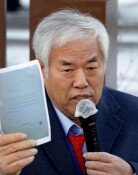[Opinion] Diabetes: A Lifetime Friend
[Opinion] Diabetes: A Lifetime Friend
Posted May. 14, 2007 07:45,
An excessively high level of sugar in the blood is known as diabetes. In a diabetics body, blood as sticky as sugared water circulates in the blood vessels hardened due to the accumulation of fat. Major symptoms are described as three increases and one decrease: higher water consumption, greater meal intake, more urination and dramatic weight loss. In Oriental medicine, diabetes is called a disease symptomized by thirst, on the grounds that a diabetes patient frequently feels thirsty. In fourth century B.C., legendary Indian surgeon Sushruta made the following description regarding a diabetic: Ants and insects flocked to [the patient] as his urine was sweet.
Diabetes has long been dubbed the disease of the rich, as it can occur due to an excessive consumption of nutrients. There were many diabetics among members of the royal family, for they ate greasy food and hardly had any exercise. King Sejong the Great is also known to have been a diabetic. Being a corpulent person with a voracious appetite, he had four meals a day and loved meat so much that he chose not to eat when there was no meat on the table. In his later years, the kings sight deteriorated so much that he could not even recognize a person sitting right next to him, and this represents a typical example of a diabetic complication. In many cases, complications from diabetes are more fatal than the disease itself.
In the first sample survey of the general public conducted by the Health Insurance Review Agency (HIRA) and the Korea Diabetes Association (KDA), 7.75 percent of the Korean population, or 2.7 million people, were estimated to be diabetics. In Korea, not only the number of diabetes patients but also the death rate for the disease are high. The death rate for diabetes is 35.3 persons per population of 100,000, the highest among member states of the Organization for Economic Cooperation and Development (OECD) and six times higher than Japans (5.9/100,000).
The annual medical expense per patient with diabetes is 2.20 million won, a figure four times greater than the average medical expense per patient for all diseases, 470,000 won. Diabetics take up less than eight percent of all patients in Korea, but their medical expenses amount to as much as 19.25 percent of what is covered in health insurance. This is why preventing and controlling diabetes requires concerted efforts at the national level.
The United States created the National Diabetes Education Program (NDEP) in 1997, and Japan recommends staying at a proper weight and walking 10,000 steps daily on average. Diabetes is an illness caused by unhealthy lifestyle habits. It is a preventable disease, and even if you already developed diabetes, you can still lead a long, healthy life when you properly respond to it. Doctors advise that you should consider diabetes a lifetime friend of yours.
Chung Sung-hee, Editorial Writer, shchung@donga.com



![[속보]국힘 윤리위, 한동훈 제명 결정…장동혁호 ‘뺄셈 정치’ 가나](https://dimg.donga.com/c/138/175/90/1/wps/NEWS/IMAGE/2026/01/14/133151701.1.jpg)



